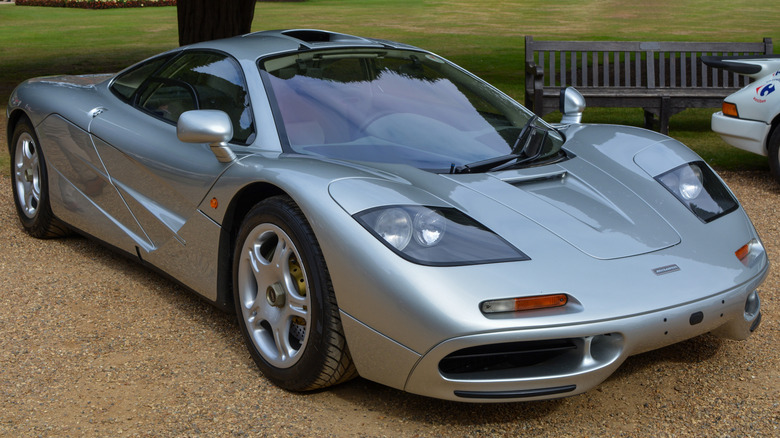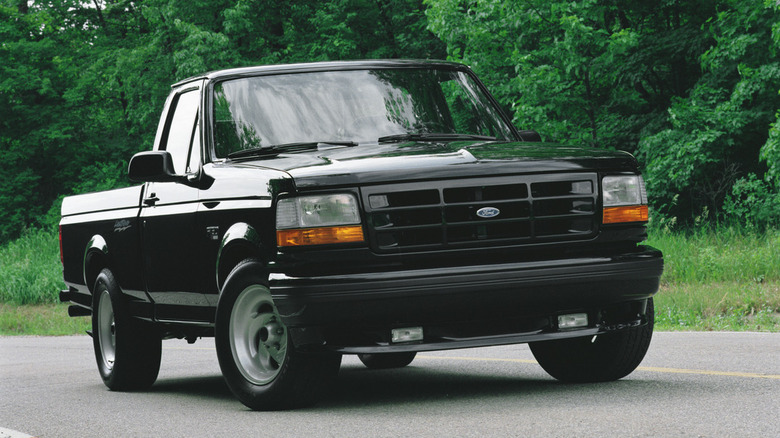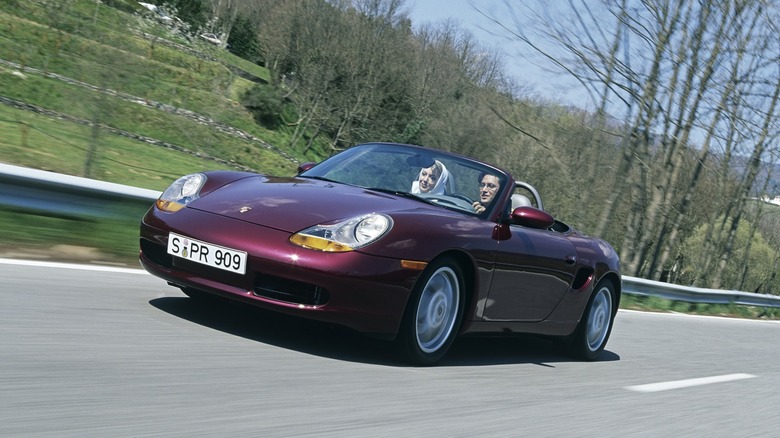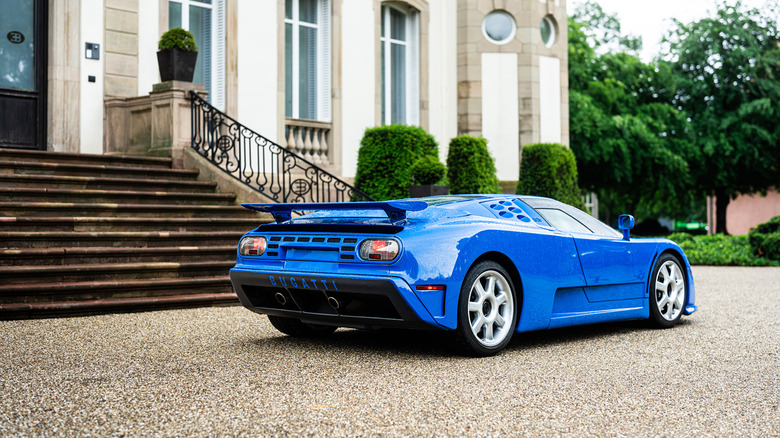Our Favorite Car Trends Of The 1990s
The automotive industry endured a dark age that began in the early 1970s and lasted well into the 1980s, a period often referred to as the Malaise Era. A pair of oil crises in 1973 and 1979, along with anti-pollution regulations, produced underpowered, under-engineered cars that have mostly, and rightly, been forgotten. Some of the worst car trends we've ever seen and some of the worst V8 engines in history had their origins in this time.
By 1990, the industry had awakened from its long slumber. Carmakers increasingly adopted electronic fuel injection or its variant, gasoline direct injection (GDi), along with weight-saving manufacturing techniques like unibody construction, resulting in faster cars with better handling. Designs evolved beyond the typically boxy styles of the '80s. New technologies began to appear, such as electronic stability control (ESC) and connectivity features, both of which remain very common today. Safety features like airbags became common in the '90s.
By the end of that decade, cars were recognizably modern, both inside and out. A driver born in the twenty-first century could jump behind the wheel of a typical 1999 model that's in good condition and feel right at home. Those of us with more than a few gray hairs may have nostalgia for cars like the incredible, Lamborghini-beating 1980s Buick Grand National, but even we have to admit that cars of the '90s, on average, were far better than their '80s predecessors. Here are five more of our favorite car trends from that decade.
Retro design
In the 1990s, car designers began to look to the past for inspiration. The Mazda Miata was a trendsetter when it debuted in 1989, inspired by classic British roadsters from MG and Austin-Healey, as well as Alfa Romeo and other European marques. The goal was to recapture the joy of driving a lightweight, drop-top two-seater, but one that featured modern technology, fuel economy, and reliability. It has a classic front-engine, rear-drive layout, near-ideal weight distribution, and a tight, driver-focused cockpit, just like the cars that inspired it.
As the decade progressed, more car models went retro. Perhaps the most famous was the Volkswagen New Beetle, which arrived in 1997. While it rode a modern Mark IV Golf chassis, everything else about the car captured nostalgia for the original Beetle, from its rounded, bug-like profile to the flower vase built into the dashboard. Its front-engine layout departed from the old-school Beetle's famous rear-engine configuration, yet its fun quotient stood out in a marketplace full of competent but somewhat anonymous commuter cars.
The debut of the Plymouth Prowler, later called the Chrysler Prowler, also garnered attention in 1997. It was inspired by vintage hot rods but featured modern touches like extensive use of aluminum in its construction. It's hard to pin down any single reason why the Plymouth Prowler was a failure, but its underpowered 3.5-liter V6 was a significant factor. Nevertheless, the Prowler is often credited with inspiring a wave of retro car designs such as the Chrysler PT Cruiser, Ford Thunderbird, and the 2010 Chevy Camaro.
Muscle trucks
In what might be seen as a harbinger of the growing importance of pickup trucks and SUVs in the American car market, the Big Three released a new crop of muscle trucks. Some of the best American muscle trucks of all time came from this decade, beginning in 1990 with the Chevy SS 454. As its name implies, it was powered by a 454-cubic-inch V8 that produced 245 horsepower and 345 lb-ft of torque. Its power output was relatively low by today's standards, but its torque was more than enough to lay down strips of rubber.
Chevy's GMC cousin released two muscle trucks in this era: The Syclone pickup truck (produced only in 1991) and an SUV called the Typhoon (built from 1992 to 1993). The Syclone was a compact GMC Jimmy buffed up with a 4.3-liter, 280-horsepower V6, while the Typhoon was the SUV version of the Jimmy with the same engine under the hood.
Ford's F-150 Lightning jumped into the fray in 1993. Its 350-cubic-inch, 240-horsepower V8 featured numerous parts from Ford Performance. A 360-horsepower Lightning debuted in 1999 and was produced until 2004. Not to be left out, in 1998, Dodge dropped the 5.9-liter Magnum V8 into its smaller Dakota pickup truck. With 250 horsepower and 345 lb-ft of torque, this gave Dodge one of the highest-horsepower pickup trucks of the 1990s at a surprisingly affordable price.
The rebirth of roadsters
We've already examined how the Miata recaptured the fun of sprightly, tossable roadsters from an earlier era. By the end of the decade, the whole roadster genre had been reborn, keying off its Mazda progenitor. The Miata alone would sell more than a million units, but it also inspired carmakers around the world to jump into the segment. The Lotus M100 Elan was launched just months after the Miata in August of 1989, resurrecting a dormant nameplate.
In 1994, a new wedge-shaped Alfa Romeo Spider brought that venerable model into the modern era. The following year, BMW released the Z3 roadster, inspired by the BMW 507 of the 1950s. In 1996, it was Lotus's turn again. It unveiled the Series 1 Elise, a super-lightweight roadster with handling that has made it a legend. The same year also saw the debuts of the Mercedes-Benz SLK and the Porsche Boxster. The latter of these two was a mid-engine, pure sports car whose handling rivals the Elise. Later, in 1999, Honda released the S2000, and Audi made a roadster version of the TT.
All of these were just the roadsters available for sale in the U.S. Overseas, the list of 1990s roadsters is enormous and includes the 1990 TVR Griffith, the 1992 MG RV8, the 1992 TVR Chimaera, the 1993 Suzuki Cappuccino, the 1995 Fiat Barchetta, the 1996 Renault Spider, and many others. Roadsters helped make driving fun again.
The SUV becomes king
Dyed-in-the-wool car enthusiasts may have mixed feelings about the 1990s trend toward SUVs, since most SUVs don't handle as well as traditional sedans and coupes, let alone sports cars. Nevertheless, since nearly half of new car sales in the U.S. were SUVs by the early 2020s, Americans clearly love these vehicles. And really, some SUVs are fun to drive, and they certainly offer tons of practicality with abundant cargo room and all-wheel drive, so it's a trend that all drivers can celebrate.
Light passenger trucks used to be fairly crude vehicles designed for everyday off-road use by ranchers, forest rangers, and others whose jobs took them far from the pavement. They weren't designed for comfort. Early utility vehicles sometimes even lacked heaters and door armrests, unless buyers ponied up for these options. But by the 1980s, truck manufacturers began to add some luxury and style to their passenger trucks.
By the 1990s, the growing popularity of SUVs among city dwellers and suburbanites had led carmakers to produce smaller, softer-riding, more civilized versions of their utes. Ford Explorers, Jeep Cherokees, and downsized Chevy Blazers sold like hotcakes, boosted by clever marketing and their own inherent practicality. Even luxury brands jumped into the segment with the 1998 Lincoln Navigator and the 1999 Cadillac Escalade. Of course, buyers could still get off-road focused SUVs like the Jeep Wrangler and the Gulf War-bred Hummer H1.
The rise of the hypercar
Anyone familiar with the iconic history of the Lamborghini Miura knows that this astonishingly beautiful, blindingly fast Italian machine gave birth to the supercar category. The 1966-1969 Miura P400's top speed of 163 mph made it the fastest car on earth in its day. Yet by the last decade of the 20th century, a new breed of exotics was blowing past the 200 mph barrier. They would come to be known as hypercars.
There is no definitive agreement on the origin of that category. Some date the word "hypercar" to the 1980s, and there's a convincing argument for this: the nearly-forgotten 200 mph Pontiac Tojan supercar can make a plausible claim to being the first production car to break that speed barrier in the mid-1980s. Later that decade, Ferrari would claim a top speed of 213 mph for its F40, but many testers could only get it into the high 190s.
However, there's no disputing whether the 1992 McLaren F1 is a true 200+ mph hypercar. Early versions were gear-limited to 221 mph, and in 1998, an F1 hit 240 mph on a test track. Other members of the 1990s 200 mph club include the 1992 Jaguar XJ220 (217 mph), the 1993 Cizeta V16T (204 mph), the 1992 Bugatti EB110 Super Sport (221 mph), the 1993 Lamborghini Diablo (202 mph), and the 1995 Ferrari F50 (202 mph).





